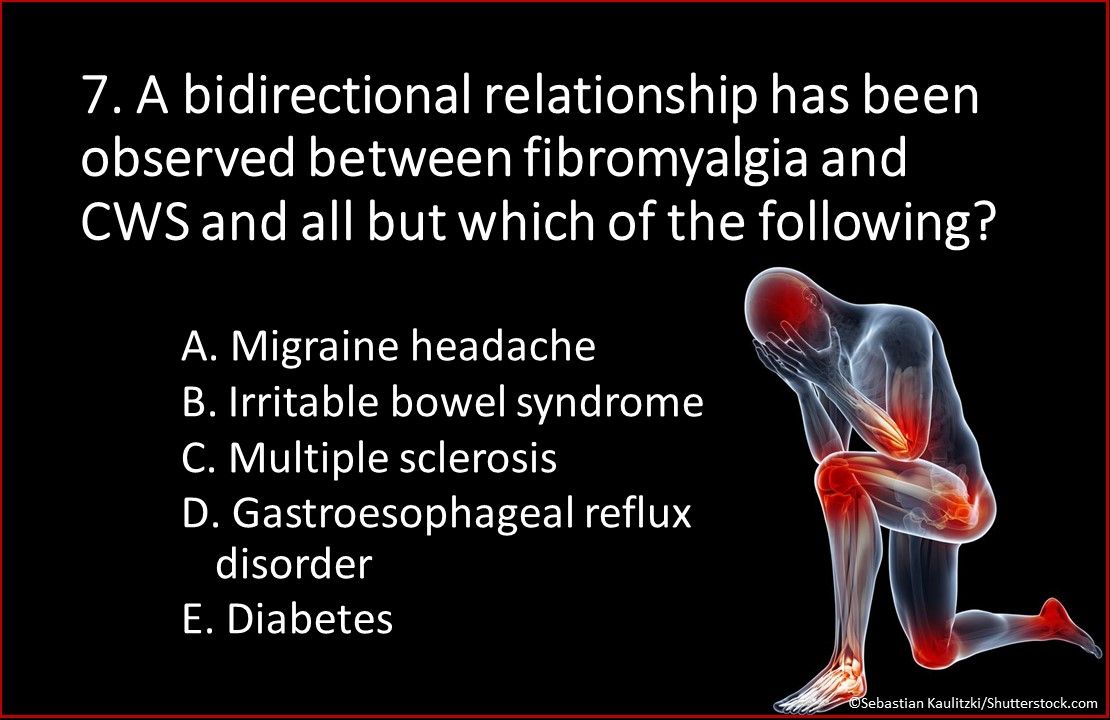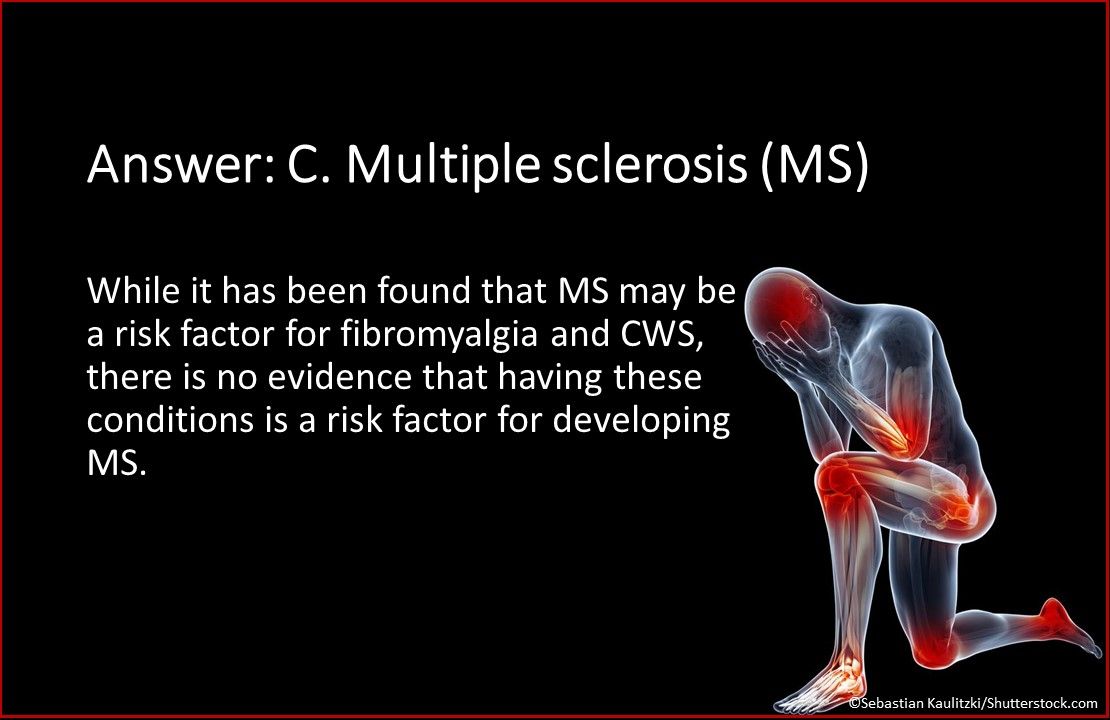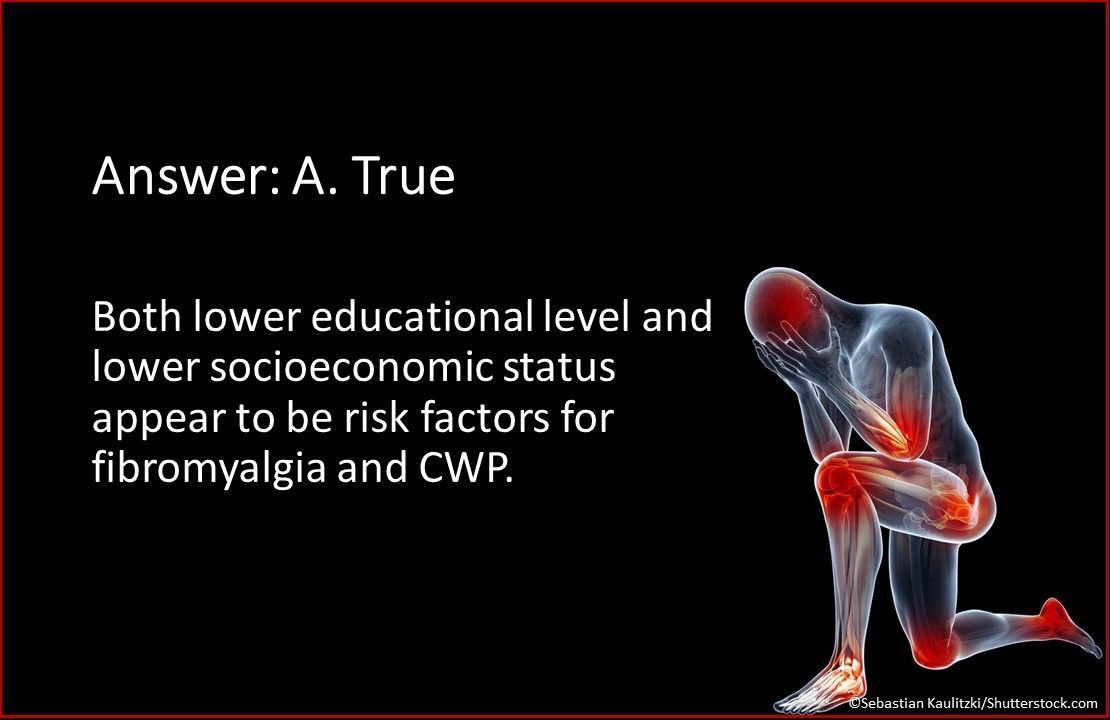© 2025 MJH Life Sciences™ , Patient Care Online – Primary Care News and Clinical Resources. All rights reserved.
Risk Factors for Fibromyalgia and Chronic Widespread Pain: A 12-question Quiz
SAMPLE: Based on current research, what is the prevalence of fibromyalgia in the general population? Plus 11 more questions on fibromyalgia and chronic pain.
A recent review published in the journal Pain examined 60 prospective cohort studies that showed incidence and risk factors for fibromyalgia and chronic widespread pain. Answer the 12 questions below for more insights.

Question 1. Based on current research, what is the prevalence of fibromyalgia in the general population?

Answer: B. 1%-6%. The variation in findings between studies is likely the result of the different diagnostic criteria used for fibromyalgia. The research indicates that the median incidence of fibromyalgia is approximately 12.5 per 1000 person-years.

Question 3. True or false? In persons with a comorbid illness, little difference has been found between men and women in the incidence of fibromyalgia.

Answer: A. True. Although women appear more likely to develop fibromyalgia, there appears to be little difference in incidence between the sexes when there is a comorbid medical condition.

Question 4. In which age group do fibromyalgia and chronic widespread pain (CWP) appear to most commonly occur?

Answer: D. Middle aged and older persons. Fibromyalgia and CWP appear to most commonly occur in those middle aged and older.

Question 5. True or false? In studies on fibromyalgia and CWP, the presence of musculoskeletal disorders appears to be the most common risk factor for developing the conditions.

Answer: A. True. The presence of a musculoskeletal disorder appears to be the most common risk factor for fibromyalgia and CWP.

Question 6. Which of the above has/have also been reported to be risk factor/s for fibromyalgia and CWP?

Answer: E. All of the above. After the presence of musculoskeletal disorders, studies have reported sleep disorders, anxiety/depression, high BMI, and smoking cigarettes to be the most common risk factors for fibromyalgia and CWP.

Question 7. A bidirectional relationship has been observed between fibromyalgia and CWS and all but which of the above?

Answer: C. Multiple sclerosis (MS). While it has been found that MS may be a risk factor for fibromyalgia and CWS, there is no evidence that having these conditions is a risk factor for developing MS.

Question 8. Based on current research, what appears to be the association between alcohol use and the presence of fibromyalgia and CWP?

Answer: B. Moderate alcohol use was least likely to be associated with fibromyalgia and CWP. Studies found that no alcohol use appeared to be a risk factor while moderate alcohol use appeared to be protective. However, it should be noted these are associations and do not indicate causation.

Question 9. True or false? Lower education level and socioeconomic status appear to be risk factors for fibromyalgia and CWP.

Answer: A. True. Both lower educational level and lower socioeconomic status appear to be risk factors for fibromyalgia and CWP.

Question 10. True or false? Current literature indicates that physical inactivity is likely to be a risk factor for fibromyalgia.

Answer: B. False. There is limited research on physical inactivity as a risk factor for fibromyalgia and findings that have been published do not clearly indicate that it is a risk factor.

Answer: B. False. The etiology of fibromyalgia has yet to be determined. In fact, the multiple risk factors that appear to be involved in its development suggest that it might have a multifactorial etiology.

Answer: D. All of the above. Challenges facing researchers of fibromyalgia include many patients who report having been diagnosed with fibromyalgia do not fit the clinical criteria for its diagnosis, many patients who say they have fibromyalgia have never been diagnosed by a physician, and many patients who have fibromyalgia are never diagnosed as having it.
Reference: Creed F. A review of the incidence and risk factors for fibromyalgia and chronic widespread pain in population-based studies. Pain. 2020;161:1169-1176.
Related Content:








